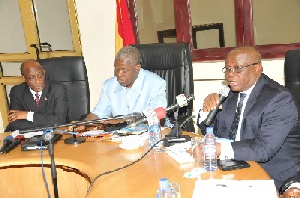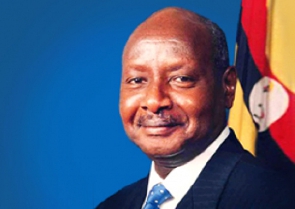Business News of Thursday, 24 July 2014
Source: Toma Imirhe | The Finder
Comment: More spending, less growth
A week ago, the Finance Minister, Seth Terkper presented Parliament with a request from government to approve a proposed GH¢3,196,855,671 in supplementary spending. Altogether, the estimate for total expenditure and arrears clearance is now GH¢36,358.3 million, [31.7% of Gross Domestic Product] up GH¢1,331.1 million from the original 2014 budget estimate of GH¢35,027.3 million. This is mainly on account of higher than originally envisaged wages and salaries, interest payments, subsidies and counter-party financing requirements for foreign-financed capital projects.
But even as government plans to increase its expenditure it acknowledges that it is still suffering revenue shortfalls and also that the original economic growth and end-of-year inflation targets are no longer achievable.
During the first five months of this year, total revenue and grants amounted to GH¢9,043.8 million [7.9% of GDP ] which was significantly short of the GH¢9,527.9 million target for the period, even though 14.3% higher than what was generated during the corresponding period of 2013.
“The shortfall in total revenue and grants for the period was the result of disbursement of project grants from our development partners and lower than expected domestic revenue collections” explains Terkper.
To partly compensate for this, government restrained its expenditure for the period keeping it down to GH¢13,170.9 million, which is 3.1% lower than the budget target for the period of GH¢13,587.5 million although still 12.6% higher than was spent in 2013.
Despite this however, government is expecting that total revenue and grants for the whole year will be more than originally anticipated rather than less. Projections for total revenues and grants for the whole year have been revised upwards slightly to GH¢26,230.3 million from GH¢26,056.5 originally. This is an optimistic 34.7% more than what was generated last year. The new estimates anticipate lower than originally expected non-oil tax revenue but higher than earlier projected oil revenue and grants.
The revision of both the expenditure and revenue projections translates into an expected overall budget deficit of GH¢10,128.1 million for the year, equivalent to 8.8% of GDP, against the earlier estimate of GH¢8,970.8 million, or 8.5% of GDP.
The supplementary budget expenditure explains Terkper has been made necessary by five factors. One is higher debt servicing costs due to higher than anticipated interest rates and borrowing levels, as well as the depreciation of the cedi which has meant higher cedi denominated interest costs on foreign debt. Another is the higher than anticipated cedi cost of foreign-financed capital expenditure, also due to the cedi’s depreciation.
The third is to meet the cost of higher than anticipated subsidies on utilities and petroleum product prices. Terkper attributes this to slower–than-expected implementation of utility and petroleum price adjustments although the ubiquitous effects of the cedi’s depreciation are, in fact, an even bigger cause of the subsidies since utility tariffs and petroleum product prices are denominated in cedis, but their cost structures are primarily import dependent.
Fourth is higher compensation payments to public sector employees, because of the implementation of a 10% Cost of Living Allowance, effective from May this year which government used to quell the spectre of strikes by public workers.
Curiously the fifth reason given by Terkper for supplementary expenditure is lower than expected tax revenues and grants, although critics point out that this should be a reason for spending cuts rather than spending increases.
Indeed, the revisions to the expenditure and revenue estimates have forced government to similarly adjust its game plan for how to finance the resultant increased fiscal deficit. The revised deficit is to be financed from domestic and foreign sources, as well as the excess amount from the stabilisation fund for debt repayment. Foreign financing of the deficit is estimated at GH¢5,936.3 million whilst domestic financing is estimated at GH¢3,856.4 million. The Stabilisation Fund is projected to contribute the other GH¢385 million by way of debt repayments.
But even as government is plotting how to step up its spending between now and the end of the year, it has acknowledged that its most important macro-economic targets, set at the turn of the year, will not be met.
Apart from the raising of the projected fiscal deficit for 2014, government has also revised its target for overall real GDP growth this year to 7.1%, down from an original target of 8.0%. Similarly, the target for non-oil real GDP growth has been revised downwards from 7.4% of GDP to 6.6%. The new target corresponds with the 6.7% growth achieved over the 12 months up to the end of the first quarter of 2014.
To be sure the slowdown in economic growth that Ghana has experienced over the past couple of years has not been debilitating in absolute terms. Until now, it has not fallen below 7% and even this compares favourably with the average growth rate for sub-Saharan Africa of about 5.5%. However, in recent years Ghana’s economic growth has been lop-sided, driven largely by investment in the oil and gas sector which is an enclave industry whose benefits do not spread all around the populace. Indeed with agricultural sector growth stuttering in recent years, it is the service sector – for more than the past decade the fastest growing sector - that has provided the benefits that have spread around the populace.
Now however Ghana has entered entirely uncharted territory. During the year up to the end of the first quarter of 2014 the fastest growing sector, at 12.7% was the agricultural sector, which over the previous few years had been the slowest growing sector. Conversely, the services sector, traditionally the fastest growing saw its growth fall to a long-term low of 4.6% The industry sector, which fuelled Ghana’s world-beating economic growth of 14.4% in 2011, through heavy investment in the fledgling oil and gas industry, actually contracted by 1.1% in the year up to March 2014, a very rare occurrence.
Another target that has been revised is that for inflation, which is now 13% plus or minus 2%, up from 9.5% plus or minus 2% originally. Again this is based on current realities; the latest consumer inflation figures, covering June, put it at 15%, which is the upper limit of the revised target band. However, inflation has been rising steadily since the first quarter of this year and is likely to climb higher on the back of the recent hikes in utility tariffs and petroleum prices, as well as the cedi’s continuing depreciation. Instructively, producer price inflation, which tracks factory price changes is currently over 20% and this holds the potential to pull consumer price inflation up towards it.
Thus, there is no certainty that even the new, less ambitious, macro-economic targets will be met. If they are not met, government will be hard pressed to justify its increased spending and wider fiscal deficit. But government officials will not worry much about this until it happens – if it happens. Until then they will be pre-occupied simply with raising the financing to pay the public sector’s bills.











